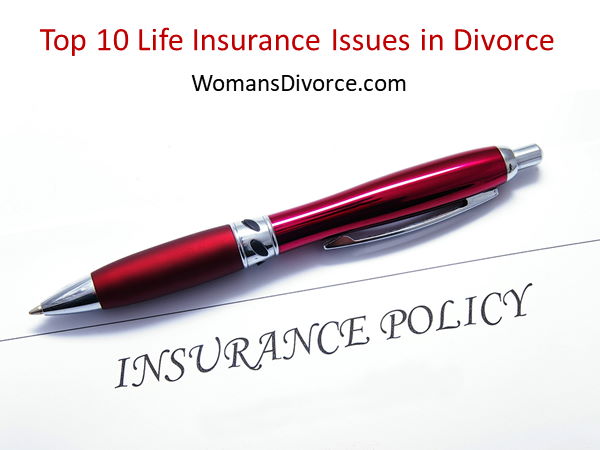- Home
- Who Gets What?
- Divorce Life Insurance
Negotiating Your Divorce - Life Insurance Issues to Consider
When hammering out the details of your divorce, life insurance should be considered in your settlement negotiations. If your husband or you are currently covered, it's important to know how the policy would be valued and divided in the divorce. Keep reading to find out more.
The Top 10 Life Insurance Issues in Divorce
by Noah Rosenfarb, Financial Expert
Life insurance is a commonly used product, but most people know very little about its intricacies especially how they should be handled in a divorce. If either spouse owns a life insurance policy before the divorce is filed, here are four things to consider:

1. Permanent insurance may have value beyond the cash surrender value listed on the statement. Anyone with terminal health issues and/or anyone over 70 have a reasonable chance of receiving more than their cash surrender value for their policy. (Life settlement transactions can be handled by either a provider or a broker.)
2. Term insurance, despite having no cash value, may also have value. If the insured's life expectancy predates the expiration of the policy, there may be someone willing to buy the policy. For example, a client had 4 years remaining on his $5,000,000 term policy when he was diagnosed with terminal cancer. The policy was quickly sold for $3,500,000 to a hedge fund. (To qualify to be sold, the term policy must be able to be converted to a permanent life policy.)
3. Whole life insurance policies are desirable assets. This type of policy pays dividends and the cash value that accumulates is tax deferred. Plus, the dividend rates on policies which are "paid up" generally exceed bonds rates. So, if a policy is 10 years old or older, it is an attractive alternative to a typical bond portfolio. So, if a policy is 10 years old or older, it is an attractive alternative to a typical bond portfolio.
In most cases, the insured keeps the life insurance policy and pays half the cash value to their spouse. However, since this asset has many desirable features, consider arguing to retain the policy whether or not your client is the insured.
4. Before liquidating a policy to satisfy equitable distribution, consider a 1035 exchange. A 1035 exchange allows an insured to "roll" the cash value of the insurance policy into an annuity without any immediate tax consequence. This may be an attractive alternative to paying tax on the liquidation of a policy.
If the divorce agreement requires life insurance coverage:
5. The insured should go through the underwriting process prior to signing the settlement agreement. If coverage will not be available due to health issues, or if the premiums are prohibitively expensive, other provisions should be included in the settlement to protect against pre-mature death, such as the creation of trusts or other estate planning tools. If you or your ex doesn't currently have life insurance coverage, getting a policy and rate comparison can help you find the best policy for your situation.
6. Minor children should not be named as beneficiaries, either individually or via a Custodian. This error is far too common, as the consequences are either unknown or not contemplated. Any payments with this designation will be placed into an UGMA account if the child has not reached the age of majority. If the Custodian is not listed on the beneficiary form, one will be appointed - and it may not necessarily be the surviving parent - a problem in and of itself. More troublesome, is that the child will receive unrestricted access to 100% of the account upon reaching the age of majority - their 18th birthday in most states.
7. If a "Trust" or "Trustee" is listed as a beneficiary and no trust exists, the death benefit will be paid to the owner of the policy. If the owner was the insured, it will be paid to their estate. Again, this designation has no relevance unless a trust is created prior to the death of the insured.
8. The reference to an "Adult Payee" does not create a fiduciary obligation. A mother named as "Adult Payee" for her children's entitlement from their father's life insurance proceeds imposes no legal obligation on the mother to utilize those proceeds for the benefit of her children. Do not create the false impression that it does, or you may expose yourself to potential malpractice claims.
9. There may be tax advantages to having the non-titled spouse (beneficiary) own the policy. Most Agreements instruct the titled spouse to obtain, own and pay for the policy. Upon their death, the non-titled spouse would receive the appropriate amount of the insurance death benefit. This could create unwanted estate tax issues for the insured.
Instead, consider structuring the agreement so the non-titled spouse obtains, owns and pays for the policy, with themselves as the beneficiary. This excludes the life insurance proceeds from the estate of the titled spouse.
Having an Irrevocable Life Insurance Trust (ILIT) to own the policy would also accomplish the same thing, but the costs to establish and maintain the trust must be considered.
10. The beneficiary should receive premium notices. Irrespective of ownership and/or payment terms, the beneficiary must be notified by the insurance company of the status of the policy. "Proof of insurance" - often required to be provided by the insured annually - fails to provide the beneficiary with proper notice to keep an insurance policy from lapsing. If the insured stops making payments, the beneficiary should be notified so they can take appropriate action.
To find out more about divorce life insurance and related health insurance matters, plus other settlement issues to keep in mind, these articles can help:
- Court Ordered Life Insurance - What to consider
- Divorce and Life Insurance FAQs - Input from the legal expert
- Health Insurance After Divorce - Questions and Answers
- Divorce and Health Insurance - Coverage options
- Handling Financial Issues after Divorce
